Economics Assignment: Analysis of Demand, Trade, and Policy
VerifiedAdded on 2023/06/03
|9
|1446
|451
Homework Assignment
AI Summary
This economics assignment delves into microeconomic principles, focusing on the concepts of demand and international trade. The first part examines the difference between change in quantity demanded and change in demand, explaining how each is affected by price and other factors, using graphical representations to illustrate market equilibrium shifts. The second part explores international trade theory, discussing absolute and comparative advantage and their role in specialization. It then analyzes Trump's protectionist policies, evaluating their potential consequences on trade, economic welfare, and trade relationships with countries like China. The assignment highlights the potential negative impacts of tariffs and protectionist measures on consumer surplus and overall economic welfare, supported by figures and references.
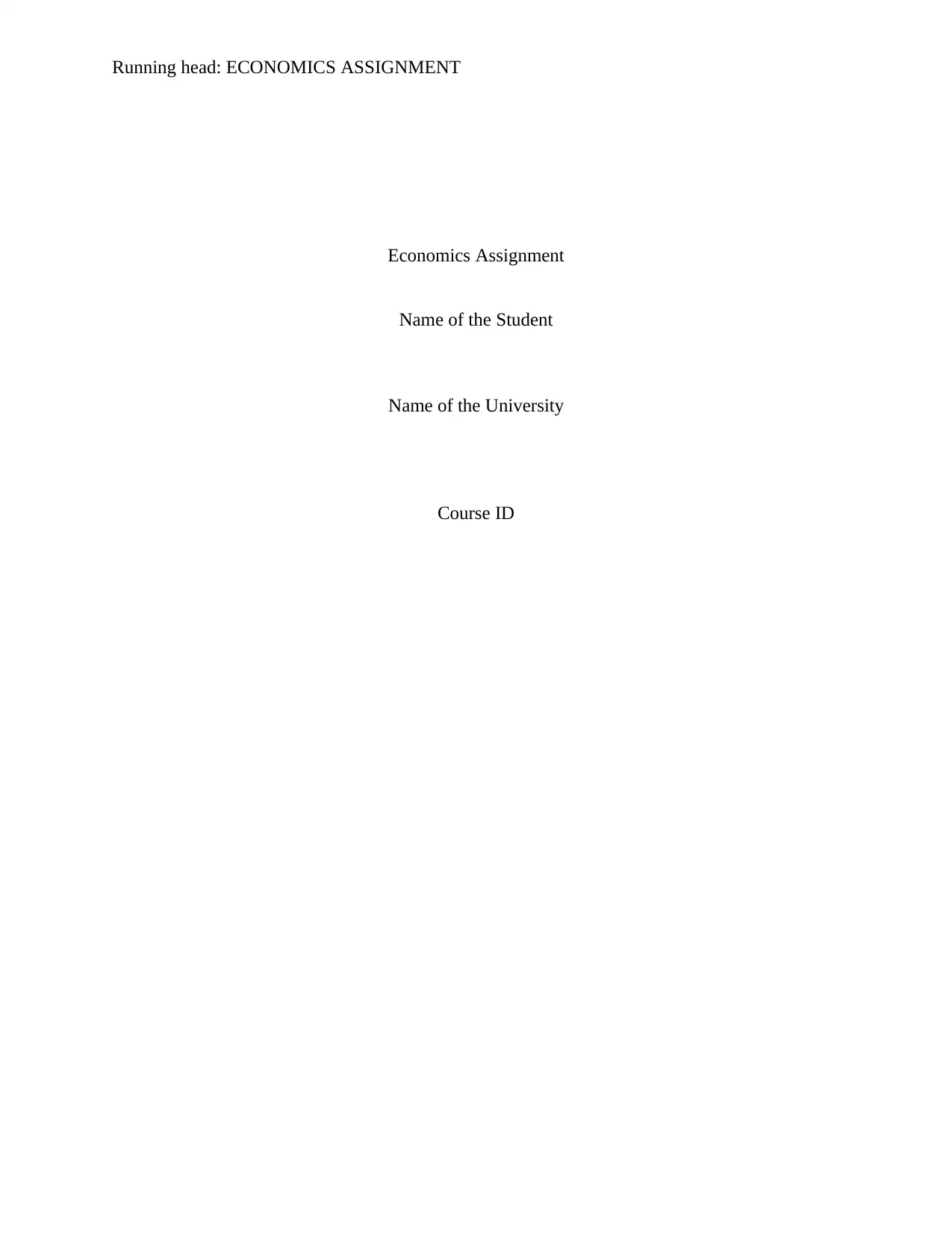
Running head: ECONOMICS ASSIGNMENT
Economics Assignment
Name of the Student
Name of the University
Course ID
Economics Assignment
Name of the Student
Name of the University
Course ID
Paraphrase This Document
Need a fresh take? Get an instant paraphrase of this document with our AI Paraphraser
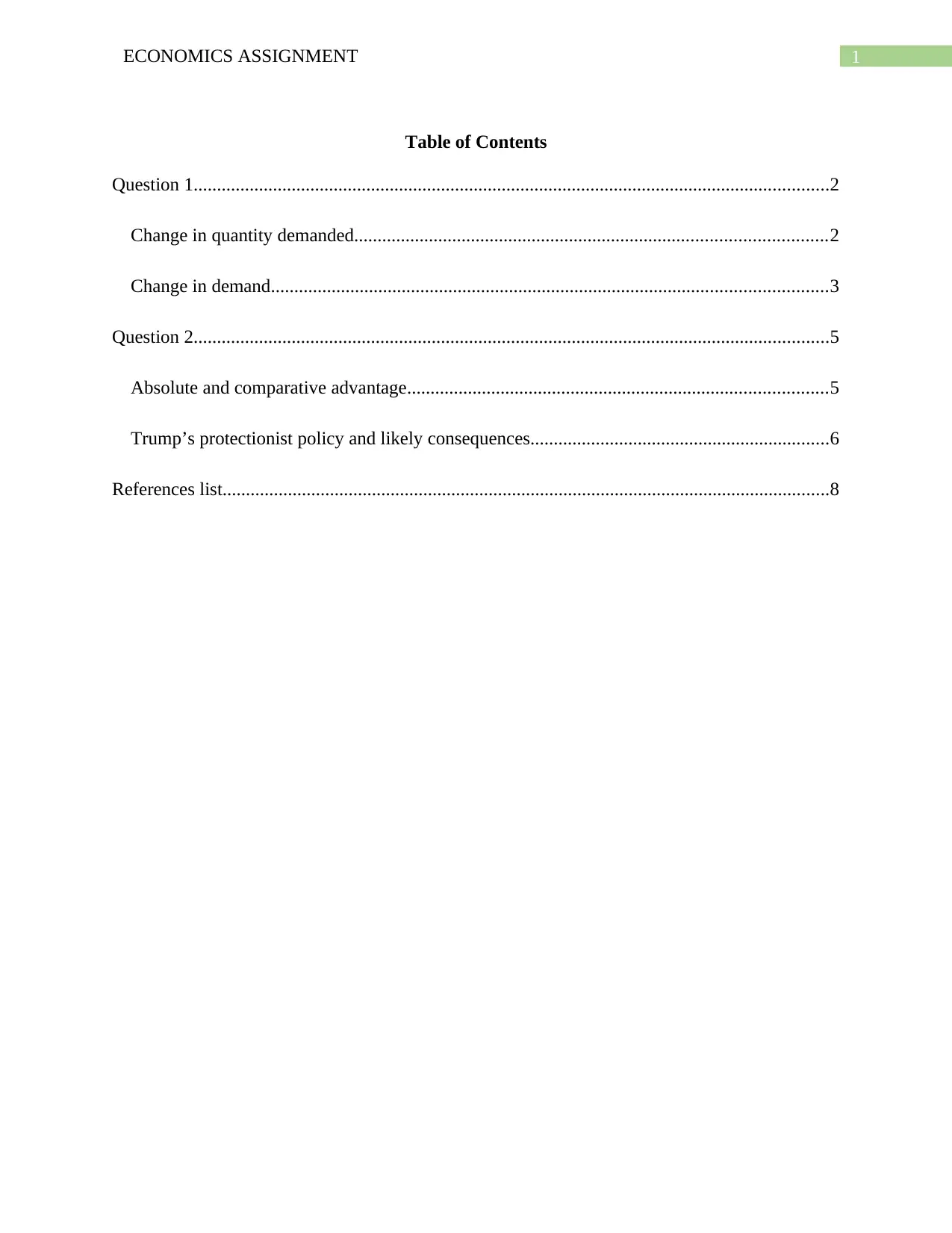
1ECONOMICS ASSIGNMENT
Table of Contents
Question 1........................................................................................................................................2
Change in quantity demanded.....................................................................................................2
Change in demand.......................................................................................................................3
Question 2........................................................................................................................................5
Absolute and comparative advantage..........................................................................................5
Trump’s protectionist policy and likely consequences................................................................6
References list..................................................................................................................................8
Table of Contents
Question 1........................................................................................................................................2
Change in quantity demanded.....................................................................................................2
Change in demand.......................................................................................................................3
Question 2........................................................................................................................................5
Absolute and comparative advantage..........................................................................................5
Trump’s protectionist policy and likely consequences................................................................6
References list..................................................................................................................................8
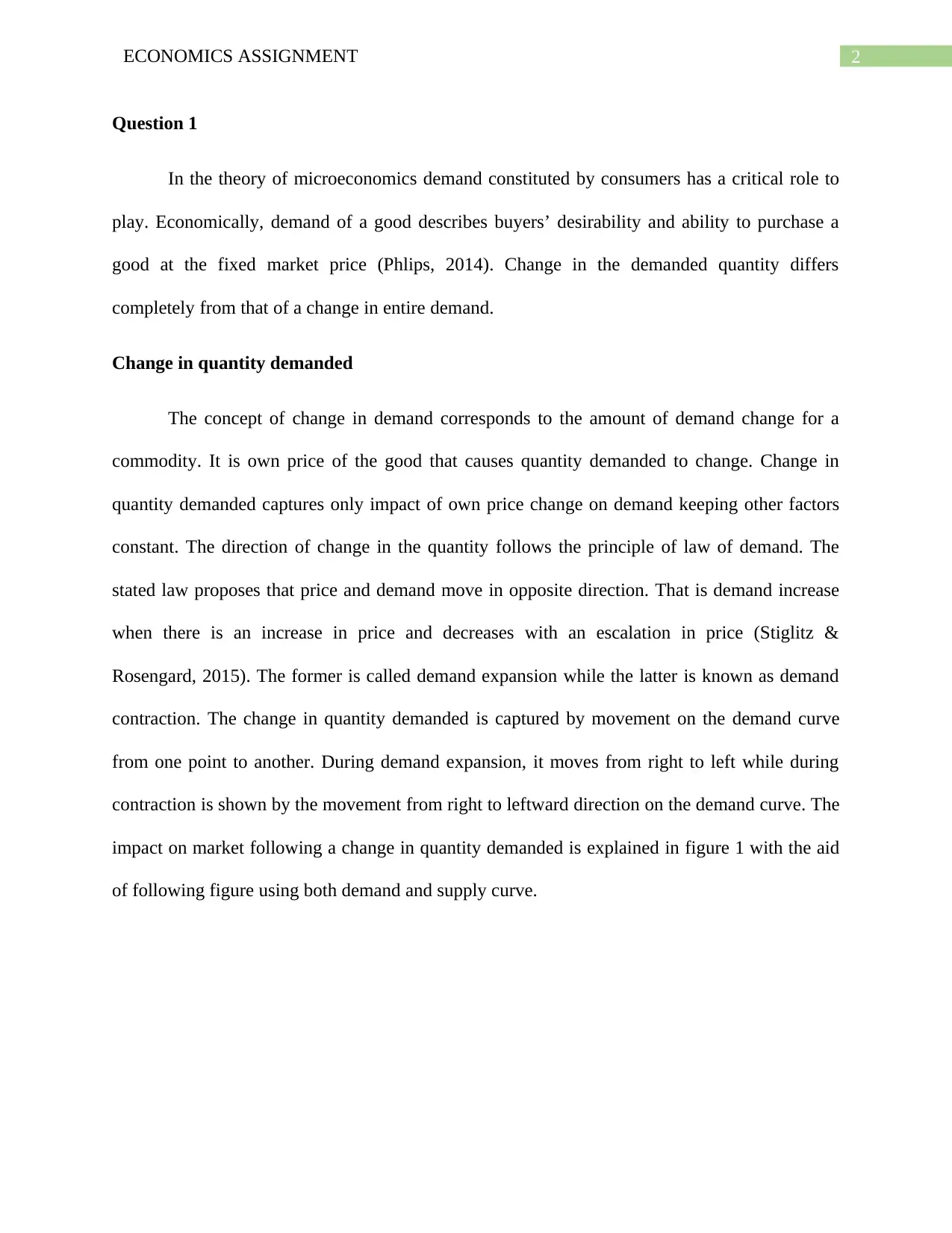
2ECONOMICS ASSIGNMENT
Question 1
In the theory of microeconomics demand constituted by consumers has a critical role to
play. Economically, demand of a good describes buyers’ desirability and ability to purchase a
good at the fixed market price (Phlips, 2014). Change in the demanded quantity differs
completely from that of a change in entire demand.
Change in quantity demanded
The concept of change in demand corresponds to the amount of demand change for a
commodity. It is own price of the good that causes quantity demanded to change. Change in
quantity demanded captures only impact of own price change on demand keeping other factors
constant. The direction of change in the quantity follows the principle of law of demand. The
stated law proposes that price and demand move in opposite direction. That is demand increase
when there is an increase in price and decreases with an escalation in price (Stiglitz &
Rosengard, 2015). The former is called demand expansion while the latter is known as demand
contraction. The change in quantity demanded is captured by movement on the demand curve
from one point to another. During demand expansion, it moves from right to left while during
contraction is shown by the movement from right to leftward direction on the demand curve. The
impact on market following a change in quantity demanded is explained in figure 1 with the aid
of following figure using both demand and supply curve.
Question 1
In the theory of microeconomics demand constituted by consumers has a critical role to
play. Economically, demand of a good describes buyers’ desirability and ability to purchase a
good at the fixed market price (Phlips, 2014). Change in the demanded quantity differs
completely from that of a change in entire demand.
Change in quantity demanded
The concept of change in demand corresponds to the amount of demand change for a
commodity. It is own price of the good that causes quantity demanded to change. Change in
quantity demanded captures only impact of own price change on demand keeping other factors
constant. The direction of change in the quantity follows the principle of law of demand. The
stated law proposes that price and demand move in opposite direction. That is demand increase
when there is an increase in price and decreases with an escalation in price (Stiglitz &
Rosengard, 2015). The former is called demand expansion while the latter is known as demand
contraction. The change in quantity demanded is captured by movement on the demand curve
from one point to another. During demand expansion, it moves from right to left while during
contraction is shown by the movement from right to leftward direction on the demand curve. The
impact on market following a change in quantity demanded is explained in figure 1 with the aid
of following figure using both demand and supply curve.
⊘ This is a preview!⊘
Do you want full access?
Subscribe today to unlock all pages.

Trusted by 1+ million students worldwide
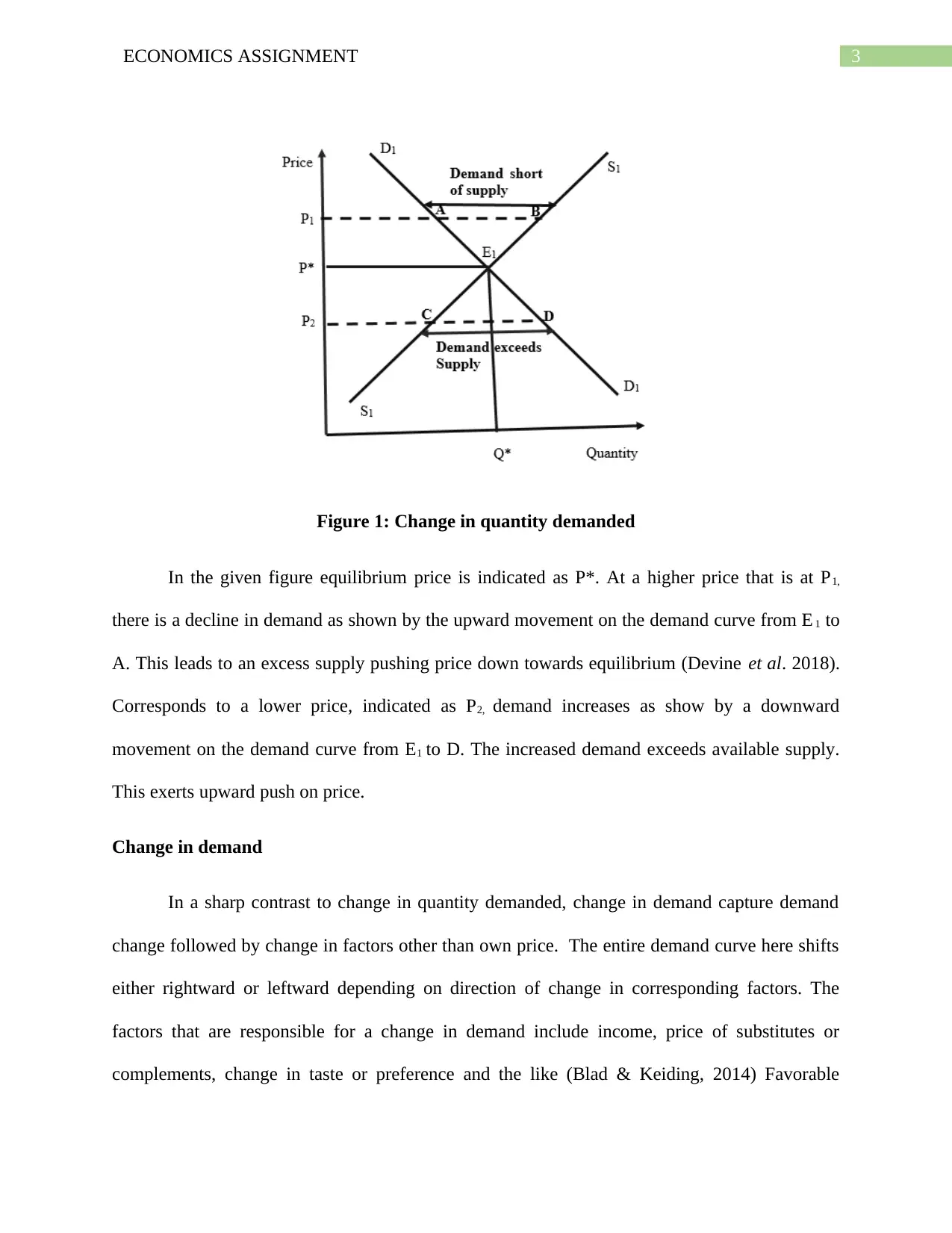
3ECONOMICS ASSIGNMENT
Figure 1: Change in quantity demanded
In the given figure equilibrium price is indicated as P*. At a higher price that is at P1,
there is a decline in demand as shown by the upward movement on the demand curve from E 1 to
A. This leads to an excess supply pushing price down towards equilibrium (Devine et al. 2018).
Corresponds to a lower price, indicated as P2, demand increases as show by a downward
movement on the demand curve from E1 to D. The increased demand exceeds available supply.
This exerts upward push on price.
Change in demand
In a sharp contrast to change in quantity demanded, change in demand capture demand
change followed by change in factors other than own price. The entire demand curve here shifts
either rightward or leftward depending on direction of change in corresponding factors. The
factors that are responsible for a change in demand include income, price of substitutes or
complements, change in taste or preference and the like (Blad & Keiding, 2014) Favorable
Figure 1: Change in quantity demanded
In the given figure equilibrium price is indicated as P*. At a higher price that is at P1,
there is a decline in demand as shown by the upward movement on the demand curve from E 1 to
A. This leads to an excess supply pushing price down towards equilibrium (Devine et al. 2018).
Corresponds to a lower price, indicated as P2, demand increases as show by a downward
movement on the demand curve from E1 to D. The increased demand exceeds available supply.
This exerts upward push on price.
Change in demand
In a sharp contrast to change in quantity demanded, change in demand capture demand
change followed by change in factors other than own price. The entire demand curve here shifts
either rightward or leftward depending on direction of change in corresponding factors. The
factors that are responsible for a change in demand include income, price of substitutes or
complements, change in taste or preference and the like (Blad & Keiding, 2014) Favorable
Paraphrase This Document
Need a fresh take? Get an instant paraphrase of this document with our AI Paraphraser
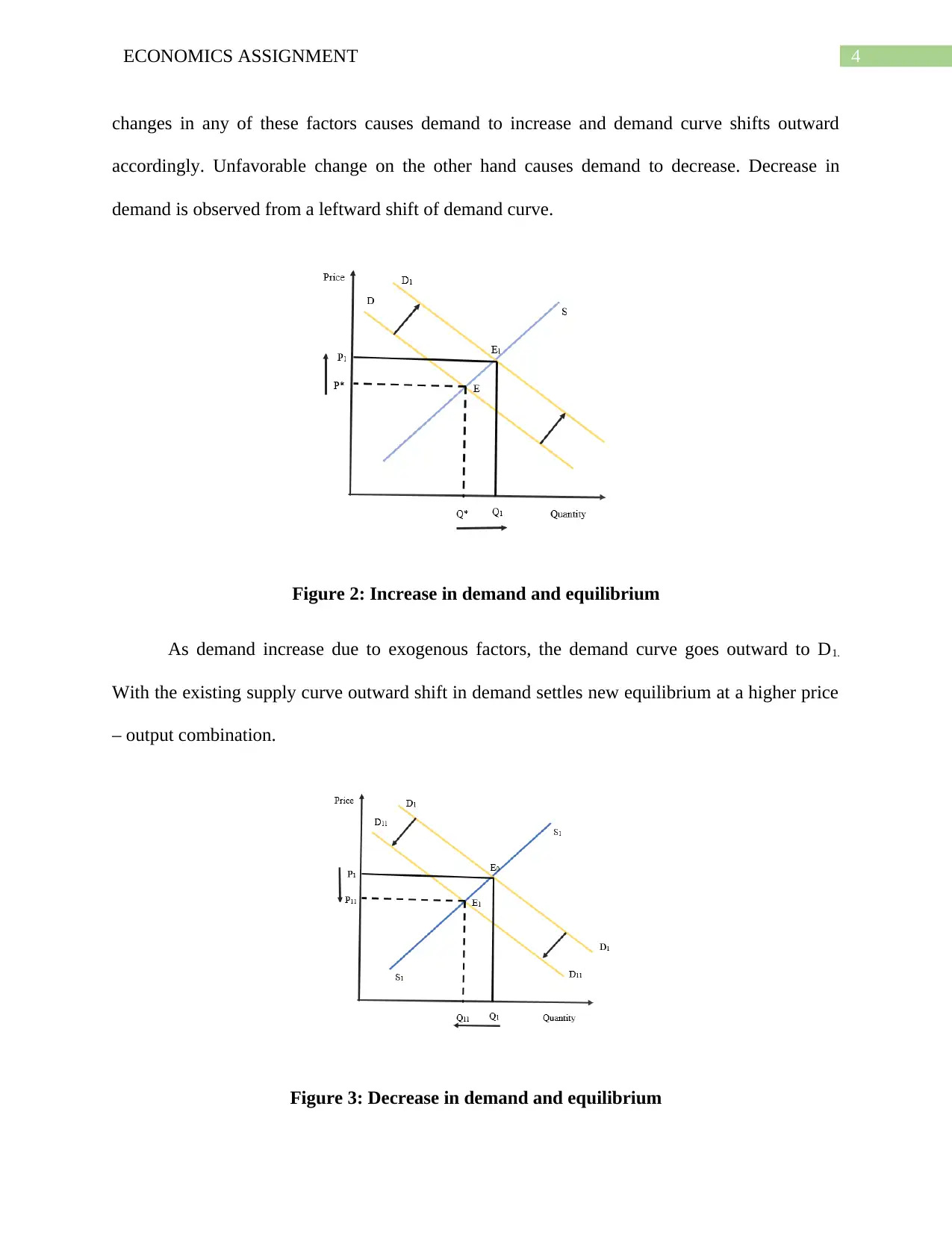
4ECONOMICS ASSIGNMENT
changes in any of these factors causes demand to increase and demand curve shifts outward
accordingly. Unfavorable change on the other hand causes demand to decrease. Decrease in
demand is observed from a leftward shift of demand curve.
Figure 2: Increase in demand and equilibrium
As demand increase due to exogenous factors, the demand curve goes outward to D1.
With the existing supply curve outward shift in demand settles new equilibrium at a higher price
– output combination.
Figure 3: Decrease in demand and equilibrium
changes in any of these factors causes demand to increase and demand curve shifts outward
accordingly. Unfavorable change on the other hand causes demand to decrease. Decrease in
demand is observed from a leftward shift of demand curve.
Figure 2: Increase in demand and equilibrium
As demand increase due to exogenous factors, the demand curve goes outward to D1.
With the existing supply curve outward shift in demand settles new equilibrium at a higher price
– output combination.
Figure 3: Decrease in demand and equilibrium
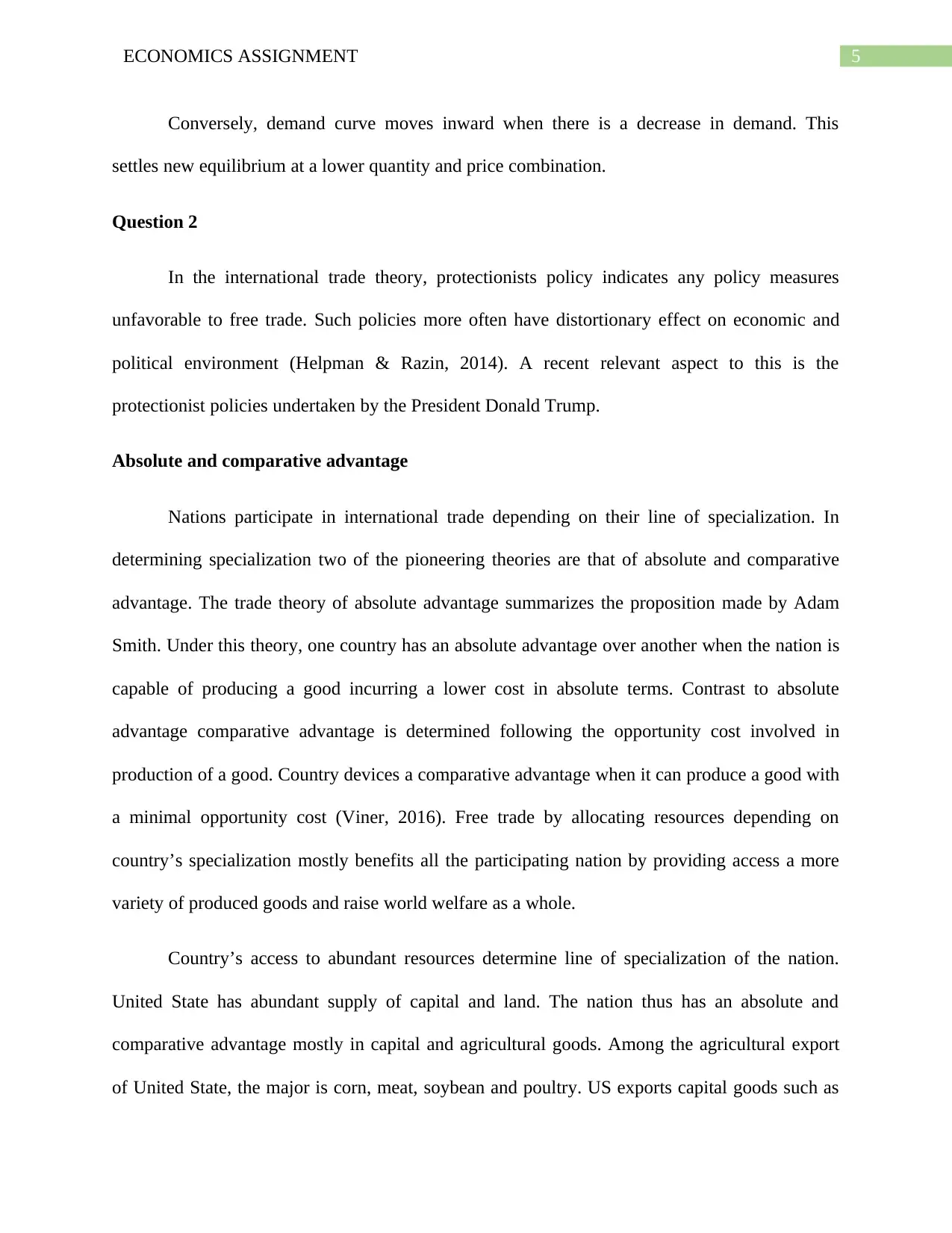
5ECONOMICS ASSIGNMENT
Conversely, demand curve moves inward when there is a decrease in demand. This
settles new equilibrium at a lower quantity and price combination.
Question 2
In the international trade theory, protectionists policy indicates any policy measures
unfavorable to free trade. Such policies more often have distortionary effect on economic and
political environment (Helpman & Razin, 2014). A recent relevant aspect to this is the
protectionist policies undertaken by the President Donald Trump.
Absolute and comparative advantage
Nations participate in international trade depending on their line of specialization. In
determining specialization two of the pioneering theories are that of absolute and comparative
advantage. The trade theory of absolute advantage summarizes the proposition made by Adam
Smith. Under this theory, one country has an absolute advantage over another when the nation is
capable of producing a good incurring a lower cost in absolute terms. Contrast to absolute
advantage comparative advantage is determined following the opportunity cost involved in
production of a good. Country devices a comparative advantage when it can produce a good with
a minimal opportunity cost (Viner, 2016). Free trade by allocating resources depending on
country’s specialization mostly benefits all the participating nation by providing access a more
variety of produced goods and raise world welfare as a whole.
Country’s access to abundant resources determine line of specialization of the nation.
United State has abundant supply of capital and land. The nation thus has an absolute and
comparative advantage mostly in capital and agricultural goods. Among the agricultural export
of United State, the major is corn, meat, soybean and poultry. US exports capital goods such as
Conversely, demand curve moves inward when there is a decrease in demand. This
settles new equilibrium at a lower quantity and price combination.
Question 2
In the international trade theory, protectionists policy indicates any policy measures
unfavorable to free trade. Such policies more often have distortionary effect on economic and
political environment (Helpman & Razin, 2014). A recent relevant aspect to this is the
protectionist policies undertaken by the President Donald Trump.
Absolute and comparative advantage
Nations participate in international trade depending on their line of specialization. In
determining specialization two of the pioneering theories are that of absolute and comparative
advantage. The trade theory of absolute advantage summarizes the proposition made by Adam
Smith. Under this theory, one country has an absolute advantage over another when the nation is
capable of producing a good incurring a lower cost in absolute terms. Contrast to absolute
advantage comparative advantage is determined following the opportunity cost involved in
production of a good. Country devices a comparative advantage when it can produce a good with
a minimal opportunity cost (Viner, 2016). Free trade by allocating resources depending on
country’s specialization mostly benefits all the participating nation by providing access a more
variety of produced goods and raise world welfare as a whole.
Country’s access to abundant resources determine line of specialization of the nation.
United State has abundant supply of capital and land. The nation thus has an absolute and
comparative advantage mostly in capital and agricultural goods. Among the agricultural export
of United State, the major is corn, meat, soybean and poultry. US exports capital goods such as
⊘ This is a preview!⊘
Do you want full access?
Subscribe today to unlock all pages.

Trusted by 1+ million students worldwide
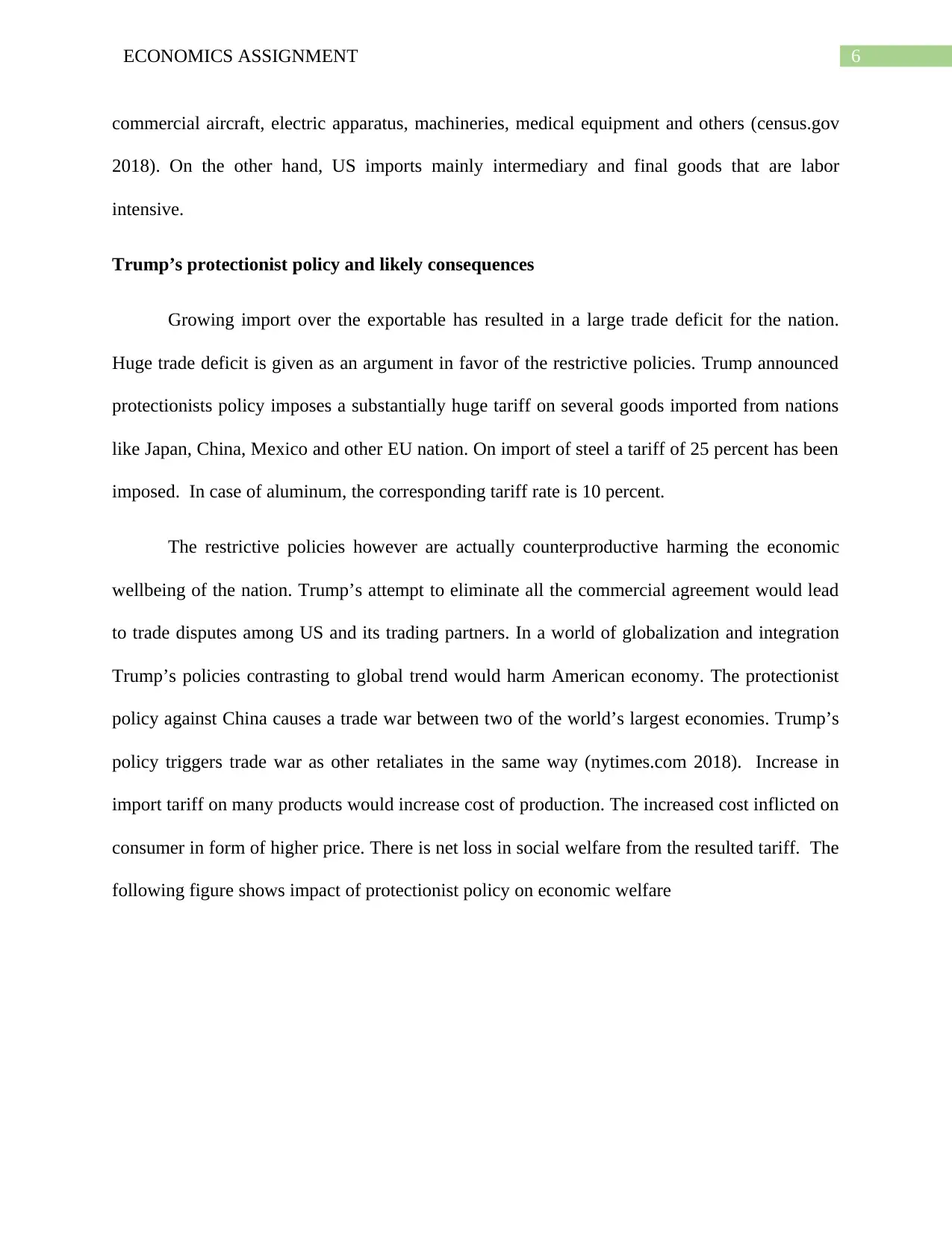
6ECONOMICS ASSIGNMENT
commercial aircraft, electric apparatus, machineries, medical equipment and others (census.gov
2018). On the other hand, US imports mainly intermediary and final goods that are labor
intensive.
Trump’s protectionist policy and likely consequences
Growing import over the exportable has resulted in a large trade deficit for the nation.
Huge trade deficit is given as an argument in favor of the restrictive policies. Trump announced
protectionists policy imposes a substantially huge tariff on several goods imported from nations
like Japan, China, Mexico and other EU nation. On import of steel a tariff of 25 percent has been
imposed. In case of aluminum, the corresponding tariff rate is 10 percent.
The restrictive policies however are actually counterproductive harming the economic
wellbeing of the nation. Trump’s attempt to eliminate all the commercial agreement would lead
to trade disputes among US and its trading partners. In a world of globalization and integration
Trump’s policies contrasting to global trend would harm American economy. The protectionist
policy against China causes a trade war between two of the world’s largest economies. Trump’s
policy triggers trade war as other retaliates in the same way (nytimes.com 2018). Increase in
import tariff on many products would increase cost of production. The increased cost inflicted on
consumer in form of higher price. There is net loss in social welfare from the resulted tariff. The
following figure shows impact of protectionist policy on economic welfare
commercial aircraft, electric apparatus, machineries, medical equipment and others (census.gov
2018). On the other hand, US imports mainly intermediary and final goods that are labor
intensive.
Trump’s protectionist policy and likely consequences
Growing import over the exportable has resulted in a large trade deficit for the nation.
Huge trade deficit is given as an argument in favor of the restrictive policies. Trump announced
protectionists policy imposes a substantially huge tariff on several goods imported from nations
like Japan, China, Mexico and other EU nation. On import of steel a tariff of 25 percent has been
imposed. In case of aluminum, the corresponding tariff rate is 10 percent.
The restrictive policies however are actually counterproductive harming the economic
wellbeing of the nation. Trump’s attempt to eliminate all the commercial agreement would lead
to trade disputes among US and its trading partners. In a world of globalization and integration
Trump’s policies contrasting to global trend would harm American economy. The protectionist
policy against China causes a trade war between two of the world’s largest economies. Trump’s
policy triggers trade war as other retaliates in the same way (nytimes.com 2018). Increase in
import tariff on many products would increase cost of production. The increased cost inflicted on
consumer in form of higher price. There is net loss in social welfare from the resulted tariff. The
following figure shows impact of protectionist policy on economic welfare
Paraphrase This Document
Need a fresh take? Get an instant paraphrase of this document with our AI Paraphraser
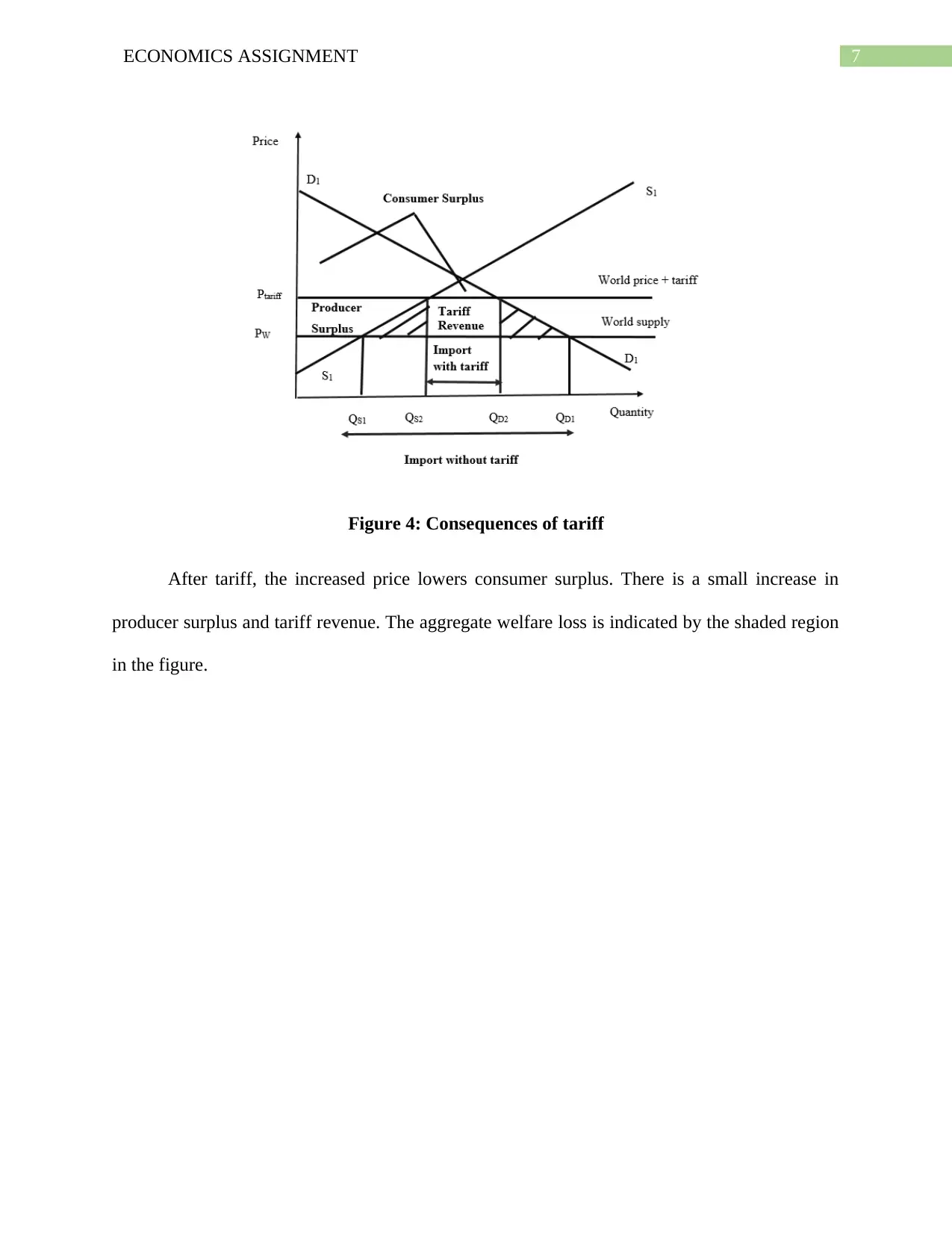
7ECONOMICS ASSIGNMENT
Figure 4: Consequences of tariff
After tariff, the increased price lowers consumer surplus. There is a small increase in
producer surplus and tariff revenue. The aggregate welfare loss is indicated by the shaded region
in the figure.
Figure 4: Consequences of tariff
After tariff, the increased price lowers consumer surplus. There is a small increase in
producer surplus and tariff revenue. The aggregate welfare loss is indicated by the shaded region
in the figure.
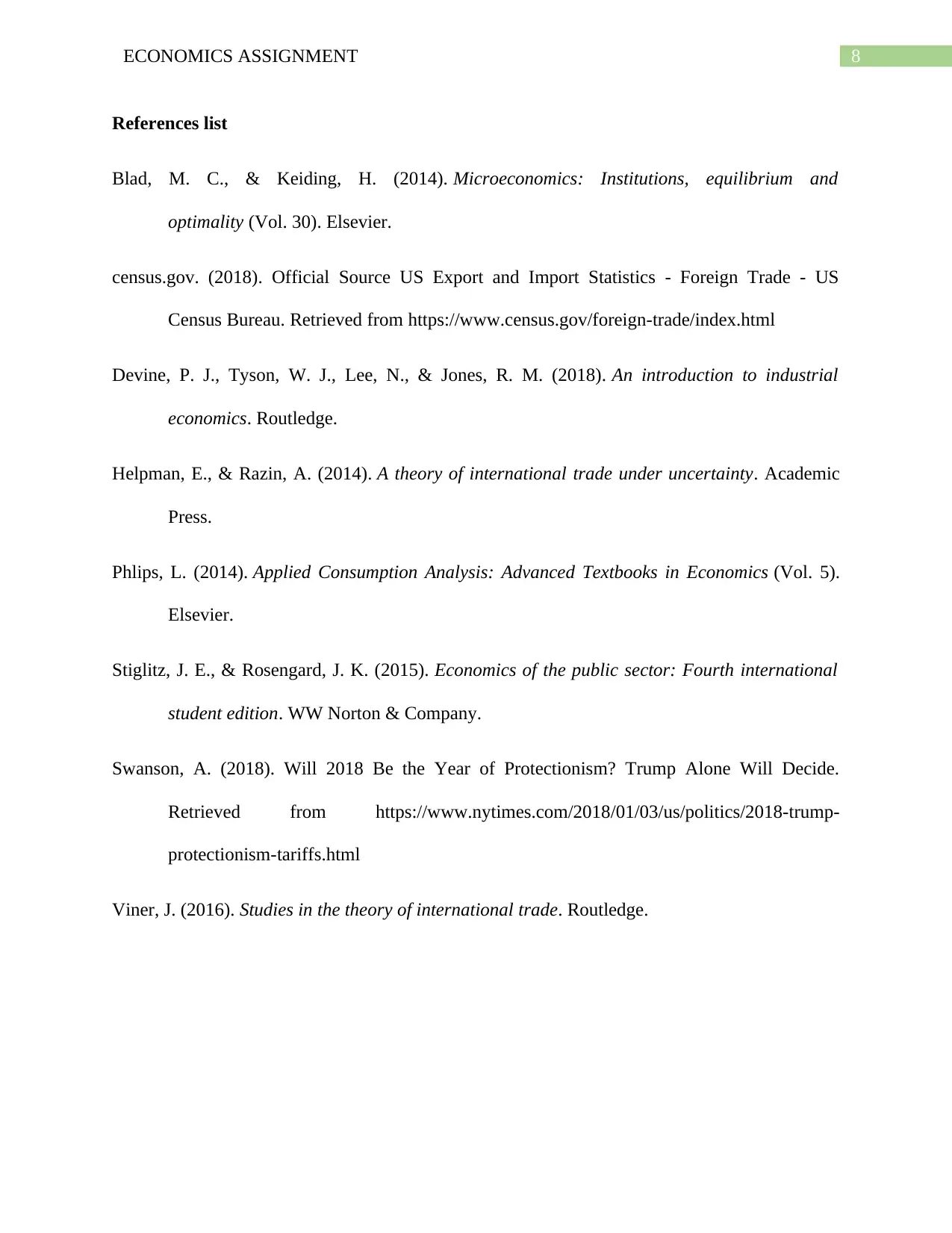
8ECONOMICS ASSIGNMENT
References list
Blad, M. C., & Keiding, H. (2014). Microeconomics: Institutions, equilibrium and
optimality (Vol. 30). Elsevier.
census.gov. (2018). Official Source US Export and Import Statistics - Foreign Trade - US
Census Bureau. Retrieved from https://www.census.gov/foreign-trade/index.html
Devine, P. J., Tyson, W. J., Lee, N., & Jones, R. M. (2018). An introduction to industrial
economics. Routledge.
Helpman, E., & Razin, A. (2014). A theory of international trade under uncertainty. Academic
Press.
Phlips, L. (2014). Applied Consumption Analysis: Advanced Textbooks in Economics (Vol. 5).
Elsevier.
Stiglitz, J. E., & Rosengard, J. K. (2015). Economics of the public sector: Fourth international
student edition. WW Norton & Company.
Swanson, A. (2018). Will 2018 Be the Year of Protectionism? Trump Alone Will Decide.
Retrieved from https://www.nytimes.com/2018/01/03/us/politics/2018-trump-
protectionism-tariffs.html
Viner, J. (2016). Studies in the theory of international trade. Routledge.
References list
Blad, M. C., & Keiding, H. (2014). Microeconomics: Institutions, equilibrium and
optimality (Vol. 30). Elsevier.
census.gov. (2018). Official Source US Export and Import Statistics - Foreign Trade - US
Census Bureau. Retrieved from https://www.census.gov/foreign-trade/index.html
Devine, P. J., Tyson, W. J., Lee, N., & Jones, R. M. (2018). An introduction to industrial
economics. Routledge.
Helpman, E., & Razin, A. (2014). A theory of international trade under uncertainty. Academic
Press.
Phlips, L. (2014). Applied Consumption Analysis: Advanced Textbooks in Economics (Vol. 5).
Elsevier.
Stiglitz, J. E., & Rosengard, J. K. (2015). Economics of the public sector: Fourth international
student edition. WW Norton & Company.
Swanson, A. (2018). Will 2018 Be the Year of Protectionism? Trump Alone Will Decide.
Retrieved from https://www.nytimes.com/2018/01/03/us/politics/2018-trump-
protectionism-tariffs.html
Viner, J. (2016). Studies in the theory of international trade. Routledge.
⊘ This is a preview!⊘
Do you want full access?
Subscribe today to unlock all pages.

Trusted by 1+ million students worldwide
1 out of 9
Related Documents
Your All-in-One AI-Powered Toolkit for Academic Success.
+13062052269
info@desklib.com
Available 24*7 on WhatsApp / Email
![[object Object]](/_next/static/media/star-bottom.7253800d.svg)
Unlock your academic potential
Copyright © 2020–2025 A2Z Services. All Rights Reserved. Developed and managed by ZUCOL.





